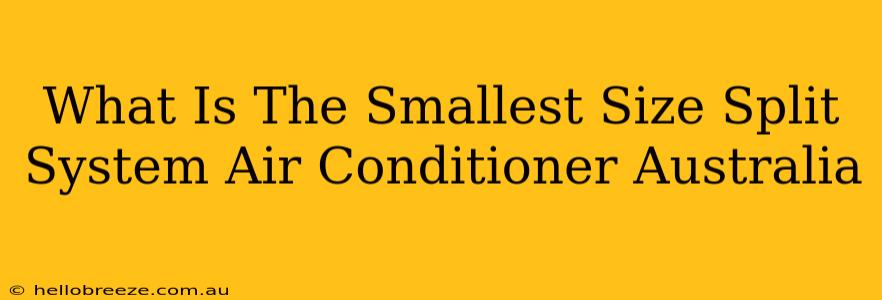Finding the perfect air conditioner for your Australian home can feel overwhelming, especially when you're dealing with smaller spaces. This guide will help you understand what constitutes a small split system air conditioner in Australia and how to choose the right one for your needs.
Understanding BTU and kW Ratings
Before we delve into sizes, it's crucial to grasp the measurement units used for air conditioner capacity. In Australia, you'll typically see cooling capacity expressed in kilowatts (kW). Older systems might still use British Thermal Units (BTU), but kW is becoming the standard. A higher kW rating indicates a more powerful air conditioner, capable of cooling a larger area.
What kW Represents
The kW rating tells you how much heat the air conditioner can remove from a room per hour. For example, a 2.5kW air conditioner can remove 2.5 kilowatts of heat per hour.
Defining "Small" in Australian Split Systems
There isn't a universally agreed-upon definition of a "small" split system air conditioner. However, generally, split systems with a cooling capacity of under 2.5kW are considered small and suitable for smaller rooms. These units are ideal for spaces like:
- Small bedrooms: A single person's room or a child's bedroom.
- Home offices: A compact workspace.
- Small living areas: Smaller apartments or studios.
Factors Affecting Air Conditioner Size Selection
Choosing the right size isn't solely about the kW rating. Several factors need consideration:
1. Room Size and Insulation:
The size of the room (length x width x height) is a primary factor. Better insulation reduces heat gain, allowing for a smaller unit. Poor insulation necessitates a larger capacity to compensate.
2. Ceiling Height:
Higher ceilings require a more powerful air conditioner to effectively cool the entire space.
3. Number of Windows and Their Orientation:
South-facing windows in Australia receive less direct sunlight, while west-facing windows can experience intense afternoon heat. More windows generally mean you'll need a larger unit.
4. Number of People and Appliances:
Occupancy and heat-generating appliances (computers, TVs) also impact the cooling load.
5. Climate Zone:
Australia's climate varies greatly. A unit suitable for a mild coastal climate might be insufficient for a hot inland location.
Finding the Right Small Split System
To determine the perfect size for your needs, it's recommended to:
- Use an online BTU/kW calculator: Many websites offer calculators that estimate the required capacity based on your room's dimensions and other factors.
- Consult an air conditioning specialist: A professional can assess your specific needs and recommend the most appropriate small split system air conditioner for your home. They can account for nuances that online calculators might miss.
Maintenance for Your Small Split System
Regular maintenance is essential for maximizing the efficiency and lifespan of your air conditioner, regardless of size. This includes:
- Cleaning or replacing air filters: Regular cleaning prevents dust buildup and improves airflow.
- Checking refrigerant levels: Low refrigerant levels can significantly reduce cooling performance.
- Professional servicing: Annual professional servicing ensures your unit is operating optimally.
Choosing the smallest size split system air conditioner that effectively cools your space requires careful consideration. By understanding the factors discussed above and seeking professional advice, you can ensure your comfort and energy efficiency.

